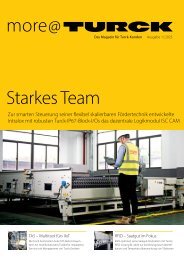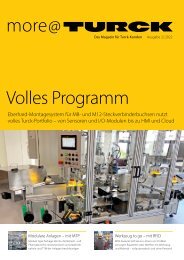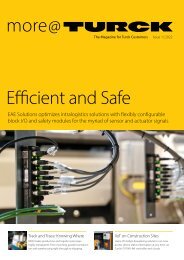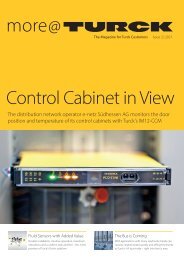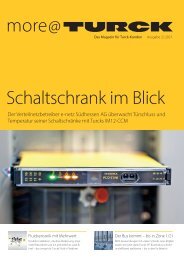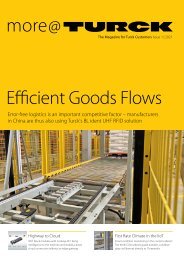more@TURCK 1_23 EN
The Magazine for Turck Customers
The Magazine for Turck Customers
You also want an ePaper? Increase the reach of your titles
YUMPU automatically turns print PDFs into web optimized ePapers that Google loves.
<strong>more@TURCK</strong> 1 | 20<strong>23</strong><br />
12 | 13<br />
We generally rely heavily on IO-Link<br />
because the protocol can transmit additional<br />
information besides the actual user<br />
data and has other advantages as well.<br />
With our inclinometer series, for example,<br />
the temperature is recorded in addition to<br />
the angle data, as is the number of operating<br />
hours. Furthermore, IO-Link also makes<br />
it possible to read out information about<br />
the application in addition to the sensor<br />
information. This is significantly more than<br />
an analog interface with 4-20 milliamps<br />
can offer. And because communication<br />
via IO-Link is very EMC-stable, the user<br />
can use unshielded, three-core cables and<br />
thus save costs.<br />
A special feature of your sensor is the<br />
so-called LED spirit level. What is the<br />
purpose of this?<br />
The spirit level is an installation aid. This<br />
means that the user does not first have to<br />
link the sensor with the controller during<br />
installation in order to deliver the process<br />
value. The user simply receives direct feedback<br />
from the sensor as soon as it is supplied<br />
with 24 volts. The yellow LEDs are<br />
permanently lit when the sensor is within<br />
a window of ±0.5 degrees around the zero<br />
position.<br />
There are already further developments<br />
of these sensors at Turck. What can we<br />
expect?<br />
After first using MEMS cells in our inclinometers<br />
to suppress disturbance vibrations,<br />
we are now also using them in our<br />
new CMVT vibration sensors. Here they do<br />
the opposite, and accurately capture and<br />
output the vibrations. CMVT stands for<br />
condition monitoring, vibration and temperature,<br />
because this is also measured by<br />
the sensor. When users read out the process<br />
data of our sensor via IO-Link, i.e. the<br />
vibration velocity, they can easily determine<br />
a possible hazard potential in their<br />
machine. If the vibration value increases<br />
gradually over time or the limits of ISO<br />
10816-3 are exceeded, then the user knows<br />
that action is needed before greater damage<br />
occurs. The sensor data also helps to<br />
carry out targeted maintenance intervals,<br />
i.e. neither too late nor too early, because<br />
that also costs money. The CMVT is also<br />
provided with switching outputs in addition<br />
to IO-Link. The user can therefore<br />
easily parameterize the sensor so that the<br />
switching output responds when set limit<br />
values are exceeded. You can then, for<br />
example, control a tower light that lights<br />
up green, yellow or red. All this fully autonomously<br />
without any controller integration<br />
required. Our Turck Vibration Monitor simplifies<br />
sensor commissioning and operation.<br />
The tool visualizes the vibration and<br />
temperature data live in any web browser<br />
and can be used easily via any Turck IO-Link<br />
master – without any additional software<br />
required. This allows the user to view the<br />
measured vibration information over a<br />
period of time, and if required, the data can<br />
be exported to Excel for further analysis.<br />
Author | The interview was conducted by Dirk<br />
Schaar, editor-in-chief of messweb.de and GOing<br />
Info | www.messweb.de<br />
Web code | more1<strong>23</strong>30e









